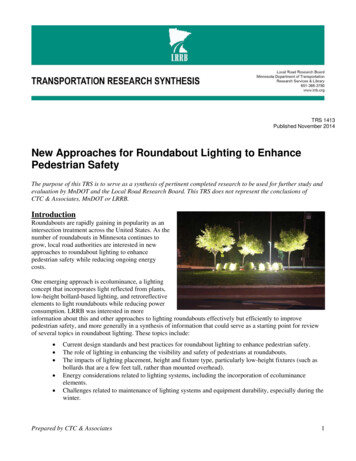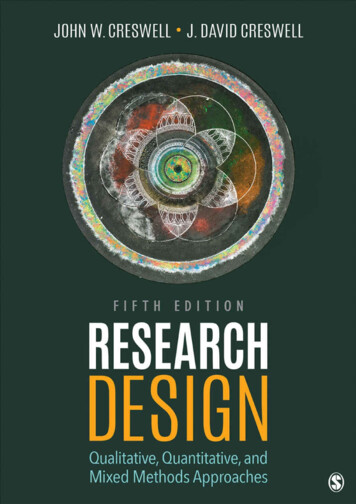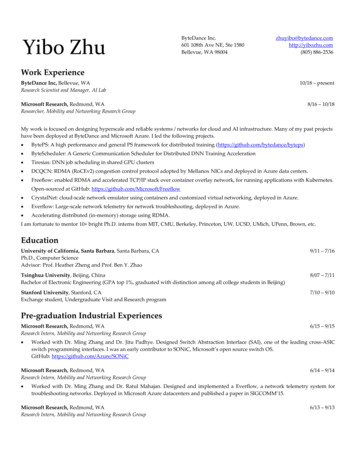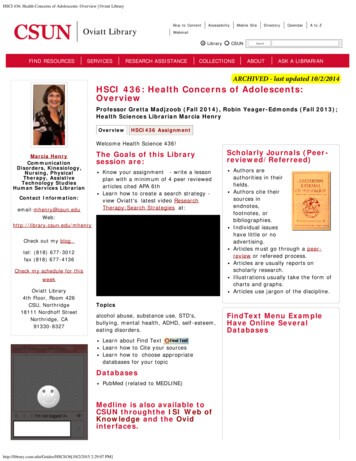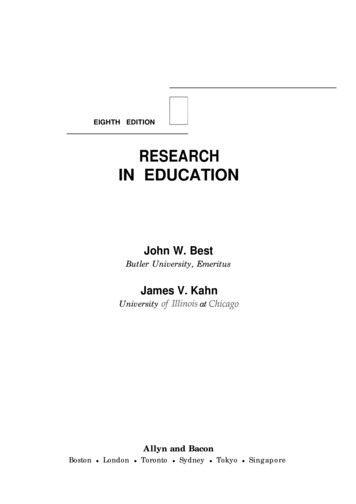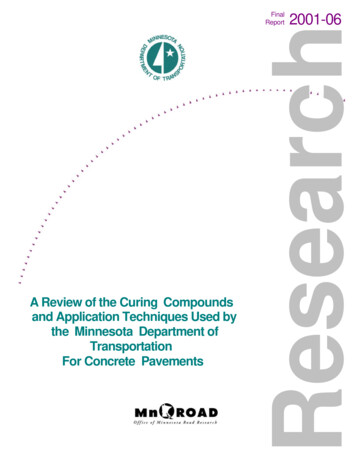
Transcription
A Review of the Curing Compoundsand Application Techniques Used bythe Minnesota Department ofTransportationFor Concrete Pavements2001-06ResearchFinalReport
A Review of the Curing Compounds and Application TechniquesUsed by the Minnesota Department of Transportationfor Concrete PavementsFinal ReportPrepared byJulie M. Vandenbossche, P.E.Minnesota Department of TransportationOffice of Materials and Road Research1400 Gervais Avenue, MS 645Maplewood, MN 55109(ph) 651.779.5565(e-mail) julie.vandenbossche@dot.state.mn.usNovember 1999Published byMinnesota Department of TransportationOffice of Research ServicesFirst Floor395 John Ireland Boulevard, MS 330St. Paul, Minnesota 55155This report represents the results of research conducted by the author and does not necessarily represent theviews or policy of the Minnesota Department of Transportation.
ACKNOWLEDGEMENTSThe author would like to gratefully acknowledge Ms. Maria Radermacher, Mr. Douglas Schwartzand Mr. Mathew Zeller from the Minnesota Department of Transportation Concrete Office fortheir assistance with this study. The author would also like to thank Mr. James McGraw for histechnical support and the rest of the Minnesota Department of Transportation ChemicalLaboratory and Mr. Rodney Patrin from the Cement and Soils Laboratory for performing thematerial testing.
TABLE OF CONTENTSIntroduction . . 1Curing Compound Characteristics . . . 2Curing Compound Test Specifications . . 3Curing Compounds Used by Mn/DOT . . 4Water Retention . . 4Volatile Organic Compounds . 8Reflectance 8Oilphase Content . 9Cost . 10Revisions to Mn/DOT Curing Specification 3754 for Standard Cure 10Applying Curing Compounds . 12Nozzle Type . 13Nozzle Spacing and Boom Height . . 15Nozzle Orientation . 16Cart Speed . . 17Wind Shield . 18Non-Uniform Coverage . 18Field Test . 19Summary .21Appendix A: Mn/DOT 1999 Specifications, Test Methods and Approval Program . A-1 to A-5
LIST OF FIGURESFigure 1. Typical nozzle spray patterns. . . 14Figure 2. Broadcast vs. band spraying. . .14Figure 3. Spray coverage. . . 15Figure 4. Maintaining adequate boom heights. . .16Figure 5. Nozzle orifice wear and damage. . . . 19Figure 6. Using multiple passes of the curing cart to apply curing compounds. . 20LIST OF TABLESTable 1. ASTM C 309 and AASHTO M 148 curing compound classifications. . . 3Table 2. Comparison between ASTM C 309 and AASHTO M 148 specifications for Type 2liquid membrane-forming compounds. 5Table 3. Curing compounds tested by Mn/DOT between Jan. 30, 1996 and May 7, 1998. 6Table 4. Reflectance testing performed by Mn/DOT between Jan. 30, 1996 and May 7, 1998. . 9Table 5. Percent oilphase for compounds used between Jan. 30, 1996 and May 7, 1998. . 9Table 6. Summary of 1999 revisions made to Mn/DOT Curing Specification 3754. . . 12
EXECUTIVE SUMMARYThe Minnesota’s Department of Transportation’s (Mn/DOT) recent implementation of a 0.40maximum water-to-cementitious ratio specification for concrete pavements has raised someconcerns regarding the availability of bleed water at the pavement surface and the moistureretained in the concrete for strength development with current curing practices. A study wasinitiated in the spring of 1998 to evaluate Mn/DOT’s concrete pavement curing requirements.First, an assessment of the effectiveness of various compounds frequently used on state fundedprojects was performed and the test methods used to evaluate these compounds were examined.Changes were made to Mn/DOT’s curing specifications based on the findings of the first portionof this study and implemented during the 1999 construction season. Methods used by contractorsto apply curing compounds were also reviewed to insure that a uniform coat of acceptablethickness is applied and recommendations were made for improving these methods. This papersummarizes the findings of this study and the resulting changes that were made to Mn/DOTconcrete pavement curing specifications. Recommendations for further improvements are alsoprovided.
IntroductionCuring consists of maintaining an appropriate temperature and moisture content in the concretefor a defined period of time so the concrete will develop in such a way that the desired materialproperties can be obtained. The scope of this project is limited to the moisture-related aspects ofcuring. A pavement has a high surface area-to-volume ratio, which makes it difficult to maintaina uniform moisture content throughout the pavement. Plastic shrinkage occurs when the rate ofwater loss from the surface exceeds the rate at which bleed water is available. The four primaryfactors that affect plastic shrinkage are concrete temperature, air temperature, wind velocity andrelative humidity. Plastic shrinkage cracking will occur if the concrete is too stiff to flow but hasnot yet developed enough strength to withstand the tensile stresses that develop due to nonuniform shrinkage. Plastic shrinkage cracks are typically 25 to 50 mm (1 to 2 in) deep and runparallel to one another 0.3 to 1 m (1 to 3 ft) apart (Mehta and Monteiro, 1993). Precautionarymeasures should be taken to prevent shrinkage cracking when the rate of evaporation of the bleedwater exceeds 1 kg/m2 /hr (2 lb/ft2 /hr) (Kosmatka and Panarese, 1992).Curing compounds are used to help prevent shrinkage cracking by reducing the evaporation ofwater from the concrete. A curing compound should be applied as soon as bleed water ceases tocollect on the pavement surface. If the compound is applied too soon, tensile stresses developwhere the bleed water collects between the pavement surface and the membrane thereby creatingpinholes in the membrane. The increase in rate of evaporation due to the pinholes increases thepotential for shrinkage cracking. Shrinkage cracks can also develop if the curing compound isapplied too late after an excessive amount of evaporation has already occurred.The Minnesota’s Department of Transportation’s (Mn/DOT) recent implementation of a 0.40maximum water-to-cementitious ratio specification (Special Provision for Specification 2301modified on 01.26.98) for concrete pavements has raised some concerns regarding the availability1
of bleed water at the pavement surface and the moisture retained in the concrete for strengthdevelopment with current curing practices. A study was initiated in the spring of 1998 toevaluate Mn/DOT’s concrete pavement curing requirements.First, an assessment of theeffectiveness of various compounds frequently used on state funded projects was performed andthe test methods used to evaluate these compounds were examined. Changes were made toMn/DOT’s curing specifications based on the findings of the first portion of this study. Thesechanges were implemented during the 1999 construction season. Finally, the methods used bycontractors to apply curing compounds were also reviewed to insure that a uniform coat ofacceptable thickness is applied.This paper summarizes the findings of this study and theresulting changes that were made to Mn/DOT concrete pavement curing specifications.Recommendations for further improvements are also provided.Characteristics of Curing CompoundConcrete pavements are commonly cured using membrane forming curing compounds.Membrane-forming curing compounds typically consist of a wax or resin that is emulsified inwater or dissolved in a solvent. The compound is applied to the pavement surface and then thewater or solvent constituent evaporates leaving the wax or resin to form a membrane over thesurface of the pavement. This membrane helps retain moisture in the concrete. Emulsifiedlinseed oil cure/sealer compounds are also used for curing concrete pavements. The oil lowersthe rate of evaporation by sealing the concrete pores while the sealant helps prevent deteriorationcaused by freeze-thaw cycling and deicing chemicals during the critical period of early strengthdevelopment.Liquid membrane-forming compounds are classified according to the color of the compound andthe type of solid constituent present for forming the membrane. Table 1 shows the AmericanSociety for Testing and Materials (ASTM) C 309 and American Association of State Highway2
and Transportation Officials (AASHTO) M 148 classifications for membrane-formingcompounds. The ASTM and AASHTO classifications are equivalent. Mn/DOT requires a Type2, Class B membrane curing compound as their standard cure for concrete pavements (Mn/DOTSpecification 2301.3) while a white pigmented, linseed oil emulsion meeting AASHTO M 148 isused for extreme weather curing (Mn/DOT Specification 3755.2).The extreme weathercure/sealer compound must be a blend of boiled linseed oil and heavy-bodied linseed oilemulsified in a water solution.An extreme weather cure is mandatory for all pavementsconstructed after September 15 north of the 46-degree parallel, after October 1 south of the 46degree parallel and before April 15 for all locations in the state (Mn/DOT Specification 3741.2).Table 1. ASTM C 309 and AASHTO M 148 curing compound classifications.COLORSOLID CONSTITUENTTypeDescriptionClassDescriptionClear or Translucent w/out DyeNo Restriction1A1-D2Clear or Translucent w/ Fugitive DyeWhite PigmentedBResinCuring Compound Test SpecificationsMn/DOT specifications require the use of Type 2, Class B curing compounds that meet ASTM C309 requirements and extreme weather curing compounds that meet AASHTO M 148specifications even though ASTM C 309 and AASHTO M 148 are identical, as seen in table 2.Mn/DOT requires extreme weather curing compounds consist of 50 4 percent oilphase and 50 4 percent waterphase, by volume. The oilphase must contain 80 percent boiled linseed oil and 20percent Z-8 viscosity linseed oil, by mass (Mn/DOT Specification 3755.2). Boiled linseed isadded to increase the set time while the more viscous linseed provides a greater contributiontowards sealing the pavement. Mn/DOT does not test to determine the percentage of eachconstituent in the oilphase.3
Curing Compounds Used by Mn/DOTMn/DOT has predominately used five different curing compounds since 1996, all of which havebeen manufactured by W.R. Meadows, Carter-Waters or Vexcon. Table 3 contains descriptionsof each curing compound used on state projects along with the results from water retention testingperformed by Mn/DOT on these compounds.Comparisons between their performance areprovided below.Water RetentionASTM C 156 and AASHTO T 155 test procedures for determining water retention under ASTMC 309 and AASHTO M 148, respectively, are identical (see table 2). There is a large amount ofvariability inherent in this test with a single-operator standard deviation of 0.13 kg/m2 (0.03lbs/ft2 ) and a multi-laboratory standard deviation of 0.30 kg/m2 (0.06 lbs/ft2 ). These standarddeviations are extremely large considering ASTM C 309 and AASHTO M 148 require a waterretention for Type 2 Class B curing compounds of less than 0.55 kg/m2 (0.11 lbs/ft2 ). Despite thedifficulties in measuring water retention, ASTM C 309 still appears to be the most promisingmeans of evaluating curing compounds, even with the large amount of variability in this testmethod.The water retention values in table 3 were determined by the Mn/DOT. Several observationswere drawn from this data. First, Carter-Waters 250/240R Linseed and W.R. Meadows 1250curing compounds exhibited the lowest water loss. Only 3 of the 141 samples tested failed but 22other samples had evaporation rates greater than 0.5 kg/m2 (0.10 lbs/ft2 ). All three failures weresamples of Vexcon Enviocure 1000. The 22 samples with evaporation rates greater than 0.5kg/m2 (0.10 lbs/ft2 ) consisted of 15 Carter Waters 250/240R samples, 4 Vexcon Enviocure 10004
Table 2. Comparison between ASTM C 309 and AASHTO M 148 specifications for Type 2 liquid membrane-forming compounds.AASHTO M 148ASTM C 309Test MethodRequirementTest MethodRequirement Comments2The AASHTO T 155 and ASTM C 156 areAASHTOT1550.55kg/mASTMC1560.55 kg/m2Water Retentionidentical tests.in 72 hrsin 72 hrsASTM E 97 60 percentASTM E 97 60 percentOnly performed on Type 2 curing compounds.ReflectanceThe AASHTO T 155 and ASTM C 156 areAASHTO T 155 4 hrsASTM C 156 4 hrsDrying Timeidentical tests. Mn/DOT specifications do notSec. 10.3Sec. 10.3Long-Term1SettlingASTM D 1309Non-volatileContentFlash PointASTM D 1644Method AASTM D 56 4(storable for atleast 180 daysw/outdeterioration)n/a10 CASTM D 1309ASTM D 1644Method AASTM D 56lbs/ft2 4.8819 kg/m2 ; F C(1.8) 321Water-emulsion type compounds can not be used once they have been allowed to freeze.5 4(storable for atleast 180 daysw/outdeterioration)n/a10 Crequire drying time testing for extremeweather curing compounds. (The Mn/DOTmaterials lab does not perform drying timetesting on curing compounds.)In case of dispute, use ASTM D 869.(Mn/DOT does not perform long-term settlingtesting on curing compounds.)(Mn/DOT does not perform flash point testingon curing compounds.)
Table 3. Curing compounds tested by Mn/DOT between Jan. 30, 1996 and May 7, 1998.Ave. WaterSampleNo. ofNo. of3LossStan. Dev. Samples FailuresProduct: Description(kg/m2 )(kg/m2 )W.R. Meadows 1250 – White:Solvent-emulsion with a resin baseCost 0.63 per liter(VOC1 120 g/L)W.R. Meadows 2230 – White:Solvent-emulsion with a resin baseCost 0.77
Table 1. ASTM C 309 and AASHTO M 148 curing compound classifications. . .3 Table 2. Comparison between ASTM C 309 and AASHTO M 148 specifications for Type 2 liquid membrane-forming compounds. 5 Table 3. Curing compounds tested by Mn/DOT between Jan. 30, 1996 and May 7, 1998. 6 Table 4. Reflectance testing performed by File Size: 474KBPage Count: 35
